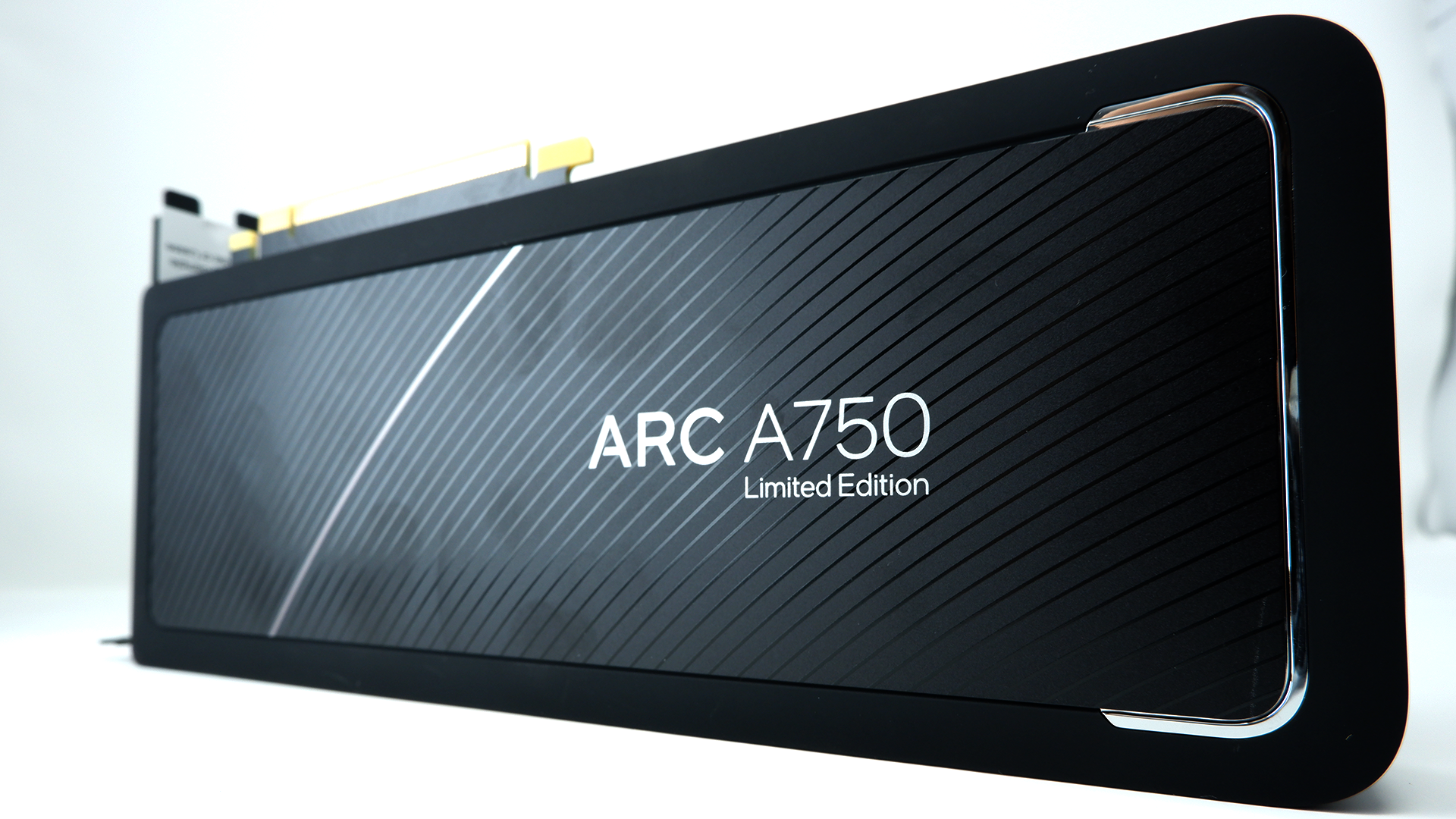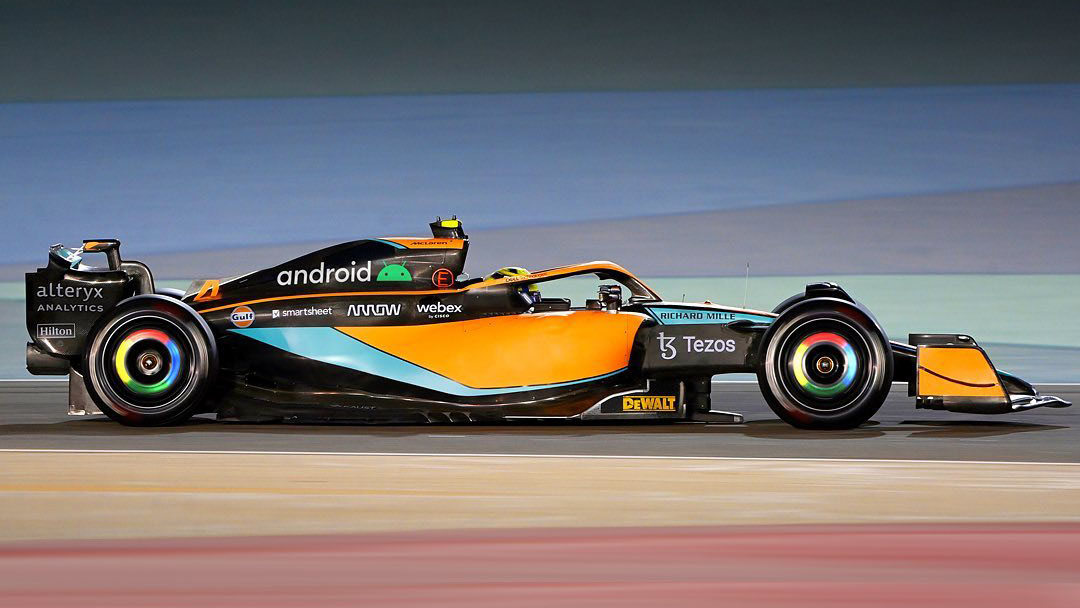
Intel's more affordable Arc GPU is pretty competitive.
We’ve seen Intel’s best graphics card to date, now it’s time to take a look at its more affordable one. The Intel Arc A750 doesn’t feign to be top of the class when it comes to frame rates, but it’s also not asking top dollar, either. At $289, this entry-level graphics card helps keep graphics card prices down at a time when you could run up a significant bill buying one. And, for that reason, the Arc A750 is perhaps even more important than its pricier sibling.
The Arc A750 offers a moderately cut-down version of the Arc A770 GPU, the G10, which you can read about more in my Intel Arc A770 review. It comes with 28 Xe-cores, the building blocks of the Xe-HPG architecture, which is only four off the 32 Xe-cores found in the Arc A770. For that, it’s not massively off the pace of that card in terms of performance, either, but it does run slightly slower and has half the total overall memory capacity.
The included 8GB of GDDR6 VRAM is plenty for the A750’s target resolution of 1080p and, as our testing shows, it also often delivers a steady 60 fps at 1440p. You’d definitely not be at a loss pairing this card with a FHD or QHD monitor. It’s surprisingly close to the Arc A770 at 4K, too, though admittedly neither card will get close to a steady 60 fps at this demanding resolution.
It’s also worth noting Intel’s Alchemist GPU architecture will perform at its best in games using either the DX12 or Vulkan APIs—essentially, the more modern APIs work best. That’s because Intel’s driver package is focused on delivering top performance in the latest games first, and it’s still working on getting those older games, on older APIs like DX11, to work as well. Intel’s graphics boss, Raja Koduri, says that the company’s drivers will “get there”, but Intel has previously admitted the process will take some time.
(Image credit: Future)
Xe-cores: 28
Ray tracing units: 28
Graphics clock (MHz): 2,050
Memory config: 8GB GDDR6 @ 16Gbps
Memory interface: 256-bit
Memory bandwidth: 512GB/s
Power (TBP): 225W
Price: $289
That’s one thing to consider with this graphics card, and its impact on your day-to-day gaming experience; it will all depend on those games you frequent most. Some long-standing competitive and service games still use DX11, such as Destiny and League of Legends, though most new ones have long since moved on to DX12 and Vulkan. You’re not going to require much graphical grunt for League of Legends or CS:GO, but it’s still not ideal to leave so much performance untapped in some games.
The other thing to consider with this GPU is that you’ll need to have Resize BAR supported on your CPU and motherboard to extract top performance out of it. That’s no issue if you have a modern CPU from either Intel or AMD, even going back to the 10th Gen and Ryzen 3000 generations. However, if you’re rocking anything older, again you won’t be able to extract full performance out of this card. In my testing the A770 was as much as 22% down at 1080p with Resize BAR disabled. The A750 will be equally affected.
I’d say that’s a deal breaker. If you can’t enable Resize BAR, don’t buy this card.
(Image credit: Future)
You’re then probably better off with one of the competitions’ cards, and at the Arc A750 level there are two key ones to consider. There’s AMD’s Radeon RX 6600 and Nvidia’s GeForce RTX 3050, both of which bring excellent GPU architectures to bear at a budget price.
The RX 6600 is the real thorn in the A750’s side. This card should be the most expensive of the lot, with an original MSRP of $329. However, nowadays it’s found for nowhere near that price tag, and even going for $250. At these prices, which appear to be common enough to be stick around, it makes both the $289 Arc A750 and $300 RTX 3050 look comparatively pricey.
1080p performance
(Image credit: Future)
(Image credit: Future)
(Image credit: Future)
(Image credit: Future)
(Image credit: Future)
(Image credit: Future)
(Image credit: Future)
(Image credit: Future)
(Image credit: Future)
(Image credit: Future)
CPU – Intel Core i9 12900K
Motherboard – Asus ROG Strix Z690-F Gaming WiFi
RAM – Trident Z 5 RGB 32GB (2x 16GB) DDR5 @5,600MHz (effective)
CPU cooler – Asus ROG Ryujin II 360mm liquid cooler
PSU – Gigabyte Aorus P1200W
Monitor – Gigabyte M32UC
The Arc A750 is usually batting around the same sort of average frame rate as the RX 6600 in most games at 1080p. There are the exceptions of Metro Exodus, which has been very well optimised for Intel Arc; Assassin’s Creed Valhalla, which AMD’s RX 6600 works best on; and Far Cry New Dawn, which also prefers AMD’s silicon.
These two cards are fairly well matched in our benchmark runs at 1080p. Though, that doesn’t necessarily work in Intel’s favour when the RX 6600 is mostly cheaper.
1440p performance
(Image credit: Future)
(Image credit: Future)
(Image credit: Future)
(Image credit: Future)
(Image credit: Future)
(Image credit: Future)
(Image credit: Future)
(Image credit: Future)
(Image credit: Future)
(Image credit: Future)
Instead it’s at 1440p where the Intel Arc A750 catches a big break. Even in Assassin’s Creed Valhalla, the Arc A750 is just edging ahead of the RX 6600. In Far Cry New Dawn it’s getting pretty close to parity, too. Generally it’s a prettier picture of performance at 1440p, so if that’s your target resolution I can see the Intel A750 appealing to you. Is it worth that extra $39? Well, it’s close, but you may be further convinced if you’re a fan of real-time ray tracing.
4K performance
(Image credit: Future)
(Image credit: Future)
(Image credit: Future)
(Image credit: Future)
(Image credit: Future)
(Image credit: Future)
(Image credit: Future)
(Image credit: Future)
(Image credit: Future)
(Image credit: Future)
Ray tracing performance
(Image credit: Future)
(Image credit: Future)
(Image credit: Future)
(Image credit: Future)
(Image credit: Future)
(Image credit: Future)
(Image credit: Future)
(Image credit: Future)
(Image credit: Future)
(Image credit: Future)
(Image credit: Future)
Synthetic benchmark performance
(Image credit: Future)
(Image credit: Future)
The Arc A750, surprisingly, is great at ray tracing, same as the Arc A770. The Arc A750 isn’t quite a match for Nvidia’s RTX 3060, but it’s not far off. That’s super impressive considering this is Intel’s first generation Ray Tracing Unit at work, and it hasn’t taken the company long at all to catch up with Nvidia’s far more mature RT Core. That said, ray tracing is still an awfully demanding graphical feature, and I’d really recommend you turn on some form of upscaling technology to take advantage of it with this card.
Intel’s own XeSS upscaling technology works a treat to improve performance on Intel’s Arc GPUs especially, thanks to XMX acceleration on the GPU. Though AMD’s FSR will also work just great.
(Image credit: Future)
As a complete picture of performance, then, Intel’s Arc A750 is certainly competitive at this price point. AMD’s RX 6600 edges out the competition at 1080p, and it’s clearly the better choice for the money at that resolution, but there’s a lot of positive stuff to be said about the Arc A750 at 1440p, and with ray tracing enabled. The architecture and the memory—likely the high memory bandwidth on this card versus the competition—seems to put it on a better footing for QHD gaming.
The performance is mostly there at 1080p, and at 1440p it’s pretty tight with the competition.
There’s no doubt as well that the Arc A750 appears simply a better graphics card for the money than an RTX 3050. Even in a game like Total War: Three Kingdoms, in which Nvidia’s RTX 3060 makes massive gains over the Arc A770, the RTX 3050 only just scrapes the lead over the Arc A750. It’s hardly a divisive victory, and for the most part the RTX 3050 is much slower.
Thermals and power
(Image credit: Future)
(Image credit: Future)
(Image credit: Future)
(Image credit: Future)
(Image credit: Future)
The Arc A750 Limited Edition is going to be a tough cooler to beat on this card, too. It’s priced at not a penny over the all-important MSRP and it’s quiet and cool, despite the card’s very high relative power draw. I’m sure third-party manufacturers will come up with some solid designs, but I’m not turning my nose up at the Limited Edition trim. It doesn’t come with the same fancy RGB LED lights as the Arc A770, unfortunately, which do look lovely, but it’s still great-looking in its own right.
So, for the cash, would I be happy with an Arc A750? Yeah, I would. The performance is mostly there at 1080p, and at 1440p it’s pretty tight with the competition—even in those games where it shouldn’t necessarily do so well. There will be cases where it’s way off the mark, and that pretty much rules this card out for anyone on an older system without Resize BAR support, but generally I think the same can be said of this card as I did in my Arc A770 review: if I bought a cheap prebuilt PC and it had an Arc A750 in it, I’d be cool with that. And for a first generation GPU, that’s actually pretty high praise.



